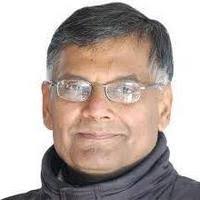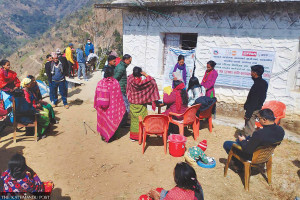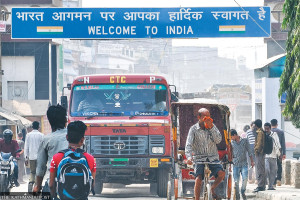 16.12°C Kathmandu
16.12°C KathmanduColumns
Countering the political theology of Hindutva
The accommodative Hindu way of life has become the Hindutva strain of European fascism.
CK Lal
From the very first sitting, the second Constituent Assembly of Nepal (2014-17) functioned more like a legislature than a convention of constitution framers. Within a year of its formation, it promulgated a charter: Drafted in haste during the aftershocks of the Gorkha Earthquake and adopted through the "fast track" without a public hearing or clause wise debate.
A brute majority marshalled through the parliamentary whips of major parties ensured that the statute didn’t have to face legislative scrutiny. The controversial constitution had no framers, only some scribes that foisted the wishes of their leaders upon the country. Among a host of anomalies in the constitution, the provision about religious freedom—broadly defined as the right to choose a religion (or no religion) without interference by the government—is more about restrictions than liberty and choice.
The statute gives an entirely new meaning to the term secular, which it explains as “religious, cultural freedoms, including protection of religion, culture handed down from the time immemorial”. Shorn of verbiage, the provision means that the protection of the dominant culture in the name of “sanatan” is the duty of the state.
In order to further confine one of the fundamental rights, the constitution ensures “the freedom to profess, practice and protect” a person’s religion but prohibits him or her from propagating it by outlawing even consensual conversion through peaceful persuasion. By forbidding the Shudras and Dalits from escaping the bondage of the hierarchical caste system, the charter has sowed the seeds of social tensions.
In late August, the possibility of a violent confrontation in Dharan over the location of a church across the street from a temple was averted due to the timely intervention of the local administration. The fundamental divergence between cultures—“handed down from the time immemorial”—of hierarchical Hindus that worship cows and relatively egalitarian ethnicities of indigenous Janajatis such as many Dolpos, Limbus and Tamangs that relish beef is difficult to reconcile.
Repeated encounters between dominant Hindus and minority Muslims in Malangwa in the month of September should ring alarm bells in society. There was a curfew in town after Krishna Janmashtami. The Vishwakarma Pooja created tensions between communities. Confrontations erupted during Ganesh Chaturthi, which necessitated the imposition of curfew orders once again.
While religious celebration with clay idols of Krishna or Durga isn’t new in Madhesh, the tradition of an immersion party—accompanied by loud music and youths in high spirits shouting aggressive slogans—taking the idols for immersion to a waterbody began in the 1960s as the country was declared to be a Hindu kingdom by the absolute monarch.
The Bhado Chauthi has always been a family festival of Chaurchan in Mithila when the moon is worshipped for peace and prosperity. The carnivalesque Ganesh Chaturthi is a recent import and an occasion for the belligerent display of religious bigotry. The accommodative Hindu way of life has slowly begun to turn into the Hindutva strain of European fascism.
Hindutva ideology
The term Hindu defies simple definition. Derived from the Persian word Hind, which traces its root to Sanskrit "Sindhu" meaning the large river that goes by the name of Indus originating in Tibet and emptying into the Arabian Sea, a Hindu for the West Asians and early Europeans was everyone who resided in what is now the South Asian landmass. Such a large area had a multiplicity of faiths that had evolved over millennia.
From ancient animism and ancestor worship to the early Vedic creed, and from the Brahminic chatur varnas to a complete rejection of ritualistic orthodoxy of Brahmans by the Shramanas, the Hindu family of faiths had the tradition of continuous innovation of religious systems. The multiplicity of creeds among Hindus frustrated the colonialists and their opponents from among the colonised alike.
Mahatma Gandhi’s response to the multiculturalism in the country was a celebration of its religious diversities. Political modernists such as Jawaharlal Nehru and Bhim Rao Ambedkar thought that a resort to constitutionalism was the only answer to India’s deep-rooted obsession with religious orthodoxies.
A Chitpawan Brahman Vinayak Damodar Savarkar, an ultranationalist initially implicated but later acquitted as an accomplice and co-conspirator in the assassination of Mahatma Gandhi, had different ideas. He thought that the homogenisation of Hinduism in the Abrahamic mould was necessary to erase Islamic influence from Indian culture.
In an eponymous pamphlet published in the 1920s, Savarkar asks “Hindutva: Who is a Hindu?” and then offers an answer: “A Hindu means a person who regards this land of Bharat Varsha as his Fatherland as well as his Holy-Land, that is the cradle land of his religion.” He then seeks to replace the idea of motherland with the bonds of a “common blood” to refashion Hindus into a race.
The Rashtriya Swayamsevak Sangh (RSS) chief MS Golwalkar further refined Savarkar’s proposition in his book We or Our Nationhood Defined by including Shramanas of Jain and Buddhist convictions but excluding all followers of Abrahamic faiths such as Judaism, Christianity and Islam from the Hindutva fold. According to Golwalkar, reconversion into Hinduism was the only way for Jews, Christians and Muslims to become bona fide members of Hindu Rashtra.
The Hindutva proposition is thus a political ideology with little or no relation to the plurality of faiths in the Hindu way of life such as Brahmanism, Vaishnavism, Shaivites, Shaktism, Tantrikas and various other contemporary religions with their own deities, rituals and priesthoods. The Hindu supremacism with the militant Ram, sacred Ayodhya, holy book Ramayana, ferocious Hanuman and vegetarianism is born out of centuries of subjugation and patterned after monotheistic religions of West Asia.
The “racial dream” of Savarkar did indeed imagine an independent Nepal’s emergence “as the Defender of the Hindu Faith and the commander of Hindu forces, mobilising ‘Hindu rifles’ to ‘spit fire and vengeance in defence of Hindu Honour’,” but the homogenising slogan of "Hindi, Hindu, Hindustan" has little resonance even in all of India, let alone in the traditions of either Madhesh or Pahad in Nepal.
European antecedents
The concept of a monotheistic religion, ethnocultural homogeneity, centralised authority, militarism and mercantilism has a long and continuous history in Europe. An Anglican England, a protestant Germany and largely Catholic Poland, Italy, Portugal, Spain and Hungary are contemporary realities long after the idea of secularity as a foundational concept of modern constitutionalism.
German political theorist Carl Schmitt (1888-1985) combined conservative beliefs of homogeneity to formulate the political theology of sovereignty, dictatorship and the necessity of “active elimination of those whom a majority perceives as internal enemies, and even celebrates that elimination as the essential activity of the popular sovereign.” It inspired Nazis and continues to fascinate presumptuous potentates of even elected variety everywhere.
The politics of Hindutva needs to be checked to prevent further destructive confrontations such as the one in Malangwa and Nepalgunj. Since it’s a political ideology, social tools of forming neighbourhood committees or taking out colourful harmony drives, peace marches and amity rallies have limited utility. Political parties wedded to the idea of a federal, democratic and secular republic must take their principles to the people to save their own relevance.


















